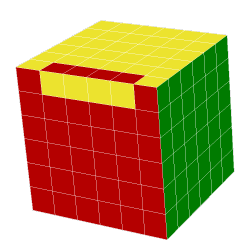| Home page | Products | Videos | Contact |
| Solutions |
V-CUBE Solution Step 3: Solving as a 3x3
Here we will finally complete our goal of completely solving our V-cube. At this point you will notice all the centers and edge groups are paired up so we can use our favorite 3x3 method to complete our solve. We will address both even and odd cubes below.
Odd Cubes:
With odd cubes the final stage will be normal, solving exactly as a 3x3 would without any special cases arising. As the size of the cube increases you will have to change/adapt your handling techniques to keep this stage fast and smooth.
Even Cubes: With even cubes the final stage will involve some special situations that only happen on even-numbered cubes. The two algs below will resolve both of these problems. The two kinds of parities that arise are the edge orientation parity and the permutation parity.
| Permutation Parity | ||
alg: 3u2 3r2 U2 3r2 R2 U2 3r2 3u2  |
 |
|
| front view | rear view | |
| This alg will swap two edge groups directly across from each other. If the last layer edges doesn't match any of the normal 3x3 last layer permuations then applying this alg will transform it into a normal case. Above is the position it directly fixes, click either picture to watch the alg performed.
There is also a position where the two swapped edge groups are next to each instead of across. To fix this situation use the same alg as above, but apply the setup moves R' U R U first. After applying the permutation parity alg, you will have to use the inverse inverse of the setup, which is U' R' U' R. As a note to the reader, in this position, the parity is actually in the corners, not the edges. It will happen 50% of the time and is caused when the edges are paired up in a way that their parity does not match the corner parity. Unless both edge and corner parity are odd or even it will not be a regular 3x3 solve. For a better understanding of parity, check out Wiki's article here. |
||
Example continued
Now we will solve the cube as normal, in our example using the CFOP method.
Cross: x' B L D B2 R2
Pair 1 (RG): y' L U' L' U L U L'
Pair 2 (RB): L' U L R' U R
Pair 3 (OG): y' R U2 R' U' R U2 R'
Pair 4 (OB): y U' R U R' U' y' R' U' R
OLL Parity: there was no OLL parity on this solve
OLL: L' U' L U' L' y' U' L' U L F
PLL Parity: 3u2 3r2 U2 3r2 R2 U2 3r2 3u2
PLL: x' R U' R' U D R' D U' R' U R D2
You should now have a complete V-cube, congratulations! With practice and hard work you can become one of the best in the world. Good luck, and remember to have fun!
Solution Step One: Solve Centers
Solution Step Two: Solve Edges
Solution Step Three: Solve as 3x3
Solution Home: Solve the V-CUBE Start Page
| News - Announcements |
